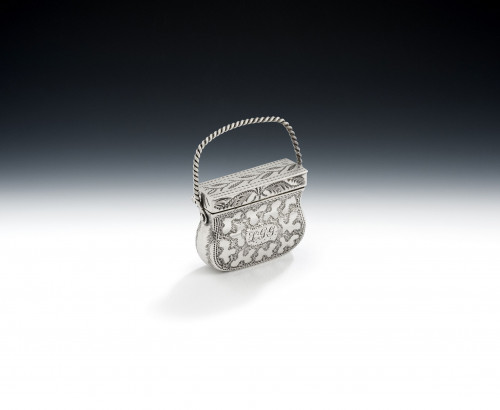- Home
- British Silver 1760-1830
- The Finedon Hall Candlesticks. An exceptional pair of George III Cast Candlesticks made in London in 1780 by John Schofield.
The Finedon Hall Candlesticks. An exceptional pair of George III Cast Candlesticks made in London in 1780 by John Schofield.
The Finedon Hall Candlesticks. An exceptional pair of George III Cast Candlesticks made in London in 1780 by John Schofield.
374820
These exceptional Candlesticks are cast and stand on a circular pedestal foot, decorated with two beaded bands in sizes. The bases rise to a tapering shaft decorated with vertical flat fluting and beaded bands. The neck of each candlestick displays a band of acanthus spears and the tulip shaped sockets are, again, decorated with flat fluting. The detachable nozzles, have a beaded rim and are engraved with a contemporary Crest. The base displays one of the most finely engraved Armorials we have seen on a piece of silver surrounded by a cartouche of foliate scrolls and beading. The Candlesticks are in quite excellent condition and are fully marked in the foot and with the maker's mark and sterling mark on the nozzles. It is argued that John Schofield made the finest Candlesticks at this date in the beaded Classical tradition. He was an exceptional silversmith who enjoyed the Royal patronage of King George III and also his son, The Prince of Wales, later King George IV. In "London Goldsmith's 1697-1837, Their Marks and Lives", A.G. Grimwade states that, " In his candlesticks and candelabra Schofield displays a high degree of elegant design executed with impeccable craftsmanship, which rivals at best the contemporary French goldsmith Henri Auguste. No one could mount glass better, as is shown by his cruet in the Rotch Collection (Victoria & Albert Museum). It seems that he worked for Jeffreys, Jones and Gilbert, the them Royal goldsmiths, and that he had considerable commissions for Carlton House".
The Arms and Crest are those of Sir William Dolben, 3rd Baronet, of Finedon Hall, Northamptonshire, (1727-1814). He was a Britsih Tory MP and a zealous campaigner for the abolition of slavery. He was born in Finedon, Northamptonshire, the only surviving son of Sir John Dolben, 2nd Baronet and his wife Elizabeth Digby, daughter of William Digby, 5th Baron Digby and Lady Jane Noel. He was educated at Westminster School and Christ Church, Oxford, matriculating in 1744. After leaving Oxford he married, in 1748, Judith, daughter of Somerset English, heiress to a considerable fortune. In 1756 he inherited the baronetcy on the death of his father.
He was appointed High Sheriff of Northamptonshire for 1760 and in 1766 a verderer of Rockingham Forest. After a short period in early 1768 as a stopgap MP for Oxford University, he was returned at the general election in March 1768 as MP for Northamptonshire from 1768 to 1774. In 1780 he was re-adopted by the university and represented them again from 1780 until 1806. On 20th April, 1797, he was appointed Captain in the Northamptonshire volunteer cavalry regiment.
During his long parliamentary career as an independent MP, he was fervent advocate of parliamentary reform and the abolition of slavery. He took up the abolitionist cause after he chanced to visit a slave ship docked in the port of London; the conditions he found on the ship so horrified him that he resolved at once to work for abolition. With the support of other abolitionists Dolben put forward a bill in 1788 to regulate conditions on board slave ships which was passed as the Slave Trade Act 1788, by a large majority.
After the death of his first wife in 1771, he married in 1789 a second cousin, Charlotte Scotchmer, nee Affeck. He died in Bury St. Edmunds in 1814 aged eighty-seven and was buried at Finedon Church. He was succeeded in his title and estates by John English Dolben, his only surviving son from his first marriage. A portrait of Sir William Dolben, after John Opie, is shown, as well as an image of Finedon Hall.
Height: 11.5 inches, 28.75 cm.
Diameter of the base:5.5 inches, 13.75 cm.
Weight: 35 oz, the pair.
Thank you for your enquiry.
We will get back to you soon.
Please create wishlist to add this item to
RELATED ITEMS




























